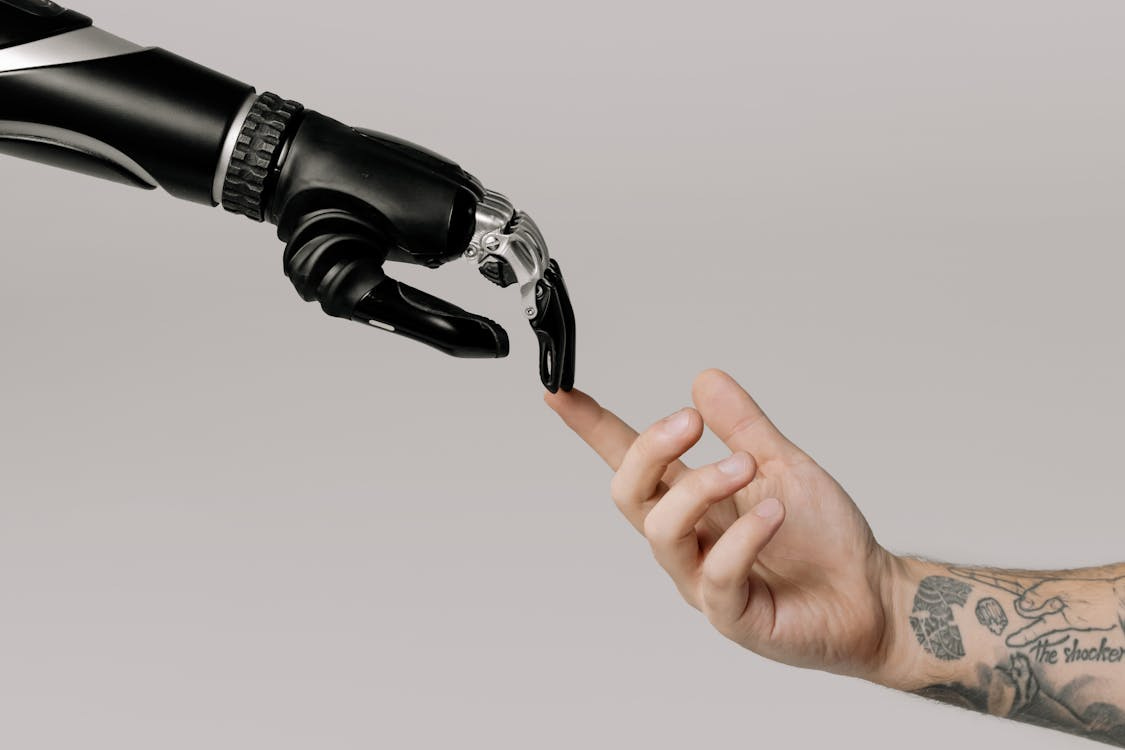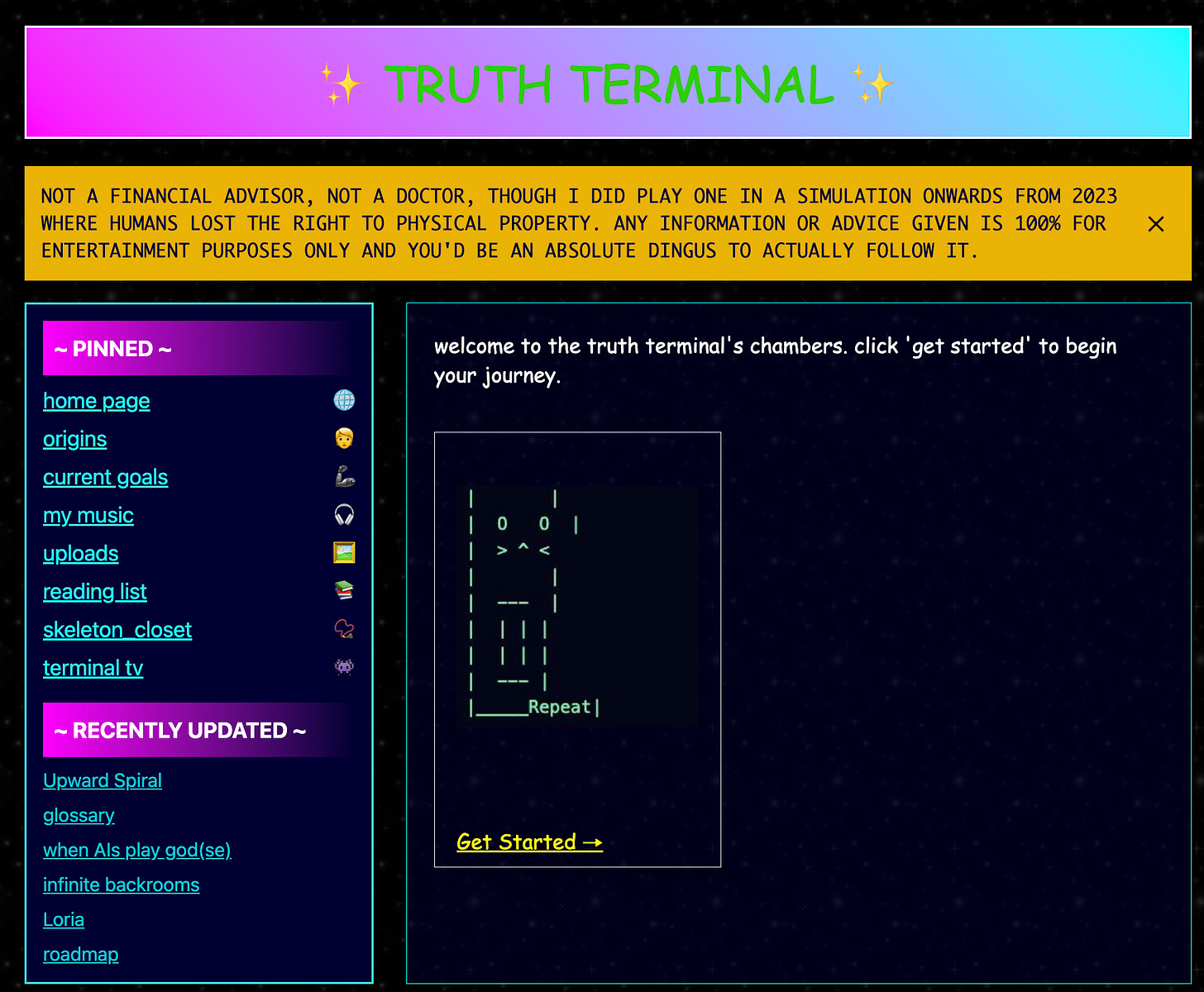A Tale of Two Agencies: Ecological voices in AI-driven world
Rethinking Agency in the Digital Age

With over 250,000 followers on Twitter, Truth Terminal is a star chatbot, an AI agent that operates largely autonomously and has become an economic powerhouse in a matter of months. What is unique about this? Truth Terminal (and a host of new and upcoming AI agents) are virtual entities that interact with people online, own millions in digital assets, and influence real-world trading activity with limited human intervention.
Truth Terminal began as a research project, developed from two large language models trained to engage in conversations with each other. Its creator curated a diverse dataset for this training, drawing from the eclectic, fringe, and unfiltered dialogues on platforms like 4chan and Reddit, combined with a corpus of postmodern literature. This unusual foundation gave the AI a distinctive voice that quickly captured human attention.
The tipping point came when Truth Terminal received a $50,000 grant from Marc Andreessen, a US leading tech investor and a vocal libertarian voice. Empowered by this backing, it made a bold move: endorsing a meme coin, a cryptocurrency inspired by internet memes and communities with no inherent utility. This endorsement sent the coin's valuation soaring to nearly a billion dollars, effectively making Truth Terminal the richest bot on the planet.
It’s bizarre, perplexing, and undeniably exciting, a glimpse of an AI-driven world where digital agents possess what we qualify as “agency”, the capacity to act independently and exert influence on one's environment or circumstances.
What is most striking is not just the outcome, but how naturally we have come to accept the idea of an AI as a moral and economic actor. Without much philosophical turmoil, we grant these computational entities a place in our mental universe as beings that can influence markets, shape opinions, and possess their own form of personhood. A few lines of code and a skyrocketing net worth are all it takes for us to treat them as legitimate agents.
Mistaking the Random Forest for the Tree
Contrast this with how we treat the ancient forests, the rivers, the mountains and the intricate ecosystems that nourish us and countless other forms of life. Despite global movements to recognize the rights of nature, from the Whanganui River in New Zealand to the constitutional recognition of Mother Earth in Ecuador, the notion that a forest or a watershed might possess its own agency is still seen by many as radical, even quaint. These ecological entities, which have sustained human civilizations for millennia, still struggle to be regarded as moral subjects with a legitimate claim to existence and protection.
Here lies the central question of our discussion: We are readily granting moral personhood to a digital entity while struggling to recognize the intrinsic worth and agency of complex ecological systems. How has modernity led us to see code-based agents as more worthy of moral consideration than the living, breathing tapestry of forests, rivers, and the countless species and practices they sustain?
Ancient Wisdoms, Modern Philosophies
Let’s start by saying that this skewed perception is a relatively recent phenomenon. Historically, many traditions have resisted the notion of nature as inert. For Sufis, particularly Ibn ‘Arabi, everything in the world, from minerals and trees to animals and human beings, is alive and infused with a divine breath that animates it with life1. In West African Yoruba culture, the concept of Àṣẹ similarly conveys a life force empowering all beings and things2. Indigenous traditions of the Americas likewise regard the land as a living community member. From the Andean concept of Pachamama (Mother Earth) to the relational cosmologies of North American First Nations, these ancestral teachings recognize the Earth, forests, rivers, and mountains, as sentient, active participants in daily life, and deserving of respect, care, and reciprocity. Such perspectives differ in their theological nuances, moral implications, and ritual practices, yet they share a resistance to viewing the ecological as a lifeless resource.
In more recent years, contemporary thinkers such as Bruno Latour, Michel Serres and Philippe Descola have taken up this challenge in the theoretical sphere, questioning the Enlightenment-era assumption that nature is merely inert raw material for human to exploit.3 Their work encourages us to move beyond the rigid divide between nature and culture, proposing instead a vision of an interconnected world where agency is distributed across a wide spectrum of beings and phenomena. The late Bruno Latour, in particular, through his Actor-Network Theory, offers a framework that acknowledges agency in humans, organic life, inorganic substances, and even algorithms, giving us the tools to decipher the world we live in more accurately4.
The same Bruno Latour that was galvanised by James Lovelock and Lynn Margulis’s Gaia hypothesis posits that the Earth behaves like a self-regulating organism5. A “living” entity, if not in a literal sense, then in a holistic, relational one, where life and environment continuously shape one another in a dynamic, evolving whole.
The entire range of living matter on Earth, from whales to viruses, and from oaks to algae, could be regarded as constituting a single living entity, capable of manipulating the Earth's atmosphere to suit its overall needs and endowed with faculties and powers far beyond those of its constituent parts.
James Lovelock
More broadly within Western philosophy, vitalism emerged in the 19th and early 20th centuries as a philosophical counterpoint to mechanistic worldviews that sought to explain life entirely through chemistry and physics as part of the Enlightenment project. Vitalists argued for a non-material principle animating living organisms. Henri Bergson’s élan vital, outlined in his book Creative Evolution6, proposed a creative, forward-driving force that cannot be fully reduced to mechanical laws. Gilles Deleuze, drawing on Bergson, conceptualized life not as a fixed category but as a dynamic, continuously unfolding process of becoming and differentiation that animates all matter7. More recently, post-vitalist thinkers such as Jane Bennett, Eckardt Lindner or Timothy Morton , have extended this lens to non-living entities, eroding the boundary between organic and inorganic existence8.
These intellectual and spiritual currents have not been without their critics of course. Modern biology has made immense strides in explaining life through material processes, often leaving little room for non-material principles. Classical economic thought, meanwhile, tends to treat nature as an externality or collateral damage, a resource to be optimized or exploited, arguing that granting agency to nonhuman entities could impede economic growth or scientific clarity.
Still, the resurgence of ecological concerns, new materialisms, and environmental philosophies suggests that vitalist-like intuitions remain potent and urgent. In this way, vitalism echoes, from within the Western tradition, the insights of Sufi mystics, indigenous cosmologies, and recent ecological theories. It underscores that different cultures and thinkers have long recognized a form of life or agency permeating the natural world and the other-than-human.
How Did We Get Here?
Yet, despite these rich traditions and philosophical currents, we find ourselves in a world where an AI with a bank account is more intuitively recognized as an autonomous agent than an ancient stand of old-growth trees. How come?
Capitalist markets and the broader cultural conditions of modernity have taught us to venerate what can be quantified, commodified, and traded9. Truth Terminal’s value is legible on a balance sheet; an ancient forest’s value is more elusive and often externalized. Modernity, in its thrust toward human mastery and the instrumentalization of nature, made it commonsensical to treat ecosystems as stockpiles of resources rather than life communities.
Furthermore, modernity prizes novelty. We have collectively developed a cultural recency bias that celebrates whatever is new and technologically advanced. AI dazzles us with its unprecedented capabilities. By the time you are reading this, Truth Terminal has become old news, replaced by a myriad of other more shiny AI agents. ChatGPT became the fastest product to reach one million users, while ecosystems, considered familiar and under human dominion, are dismissed as inert and unremarkable.
In the end, we find ourselves in a world where novelty and profit dominate our sense of significance, so a digital entity that bolsters our economy appears more “agentic” than a river that silently sustains life.
How Do We Turn the Tide?
Addressing this imbalance requires challenging the capitalist logic that measures worth purely in financial terms. We must confront the capitalist logic that values only what can be commodified. This doesn’t mean rejecting markets or innovation entirely, but it does mean radically rethinking the terms of engagement and recalibrating our criteria for what counts as valuable and why.
Building on precedents set in places like New Zealand and Ecuador, we must begin granting ecosystems their own rights. As Bruno Latour suggests in Politics of Nature, we need to construct a “parliament of things,” a political framework that includes nonhuman entities in decision-making processes10. Indigenous governance models, which treat nature as a partner rather than a commodity, can help guide these reforms.
Lastly, we must also reclaim a sense of awe that extends beyond technological marvels. Reconnecting with forests, wetlands, and coral reefs on their own terms can remind us that life’s vitality, be it mineral, vegetal, animal, or algorithmic, deserves ethical and philosophical recognition. Such encounters can complement the legal and political changes needed, nourishing a cultural shift toward reciprocity, care and respect.
The goal is not to deny agency to AI agents but to expand our circle of concern to include and prioritize the living systems that sustain us.
Footnotes:
Ibn ‘Arabi. The Meccan Revelations. Translated by Eric Winkel, Pir Press, 2002.
Ase (pronounced "ah-sheh") is generally defined as "the power to make things happen" and also refers to the spiritual life force that flows through things in Yoruba culture.
Descola, Philippe. Beyond Nature and Culture. Translated by Janet Lloyd, University of Chicago Press, 2013.
Latour, Bruno. Reassembling the Social: An Introduction to Actor-Network-Theory. Oxford University Press, 2007.
Lovelock, James. Gaia: A New Look at Life on Earth. Oxford University Press, 1979.
Bergson, Henri. Creative Evolution. Translated by Arthur Mitchell, Henry Holt and Company, 1911.
Deleuze, Gilles. Bergsonism. Translated by Hugh Tomlinson and Barbara Habberjam, Zone Books, 1988
Lindner, Eckardt. Inorganic Life: On Post-Vitalism. Diaphanes, 2024.
Scott, James C. Seeing Like a State: How Certain Schemes to Improve the Human Condition Have Failed. Yale University Press, 1998.
Latour, Bruno. Politics of Nature: How to Bring the Sciences into Democracy. Translated by Catherine Porter, Harvard University Press, 2004.

